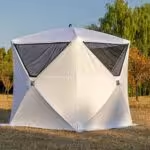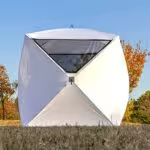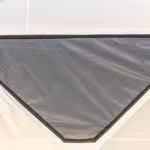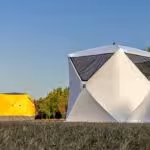Welcome to My Blog!
Before we dive into the content, I’d love for you to join me on my social media platforms where I share more insights, engage with the community, and post updates. Here’s how you can connect with me:
Facebook:https://www.facebook.com/profile.php?id=61569274896143
Now, let’s get started on our journey together. I hope you find the content here insightful, engaging, and valuable.
Table of Contents
Introduction

Ice fishing is a thrilling winter activity, but staying warm and protected from harsh weather conditions is essential for an enjoyable experience. A high-quality ice fishing insulated tent provides warmth, wind resistance, and durability, ensuring that anglers can focus on fishing rather than battling the elements. This guide will help you choose the perfect ice fishing insulated tent by outlining key factors such as insulation quality, size, setup convenience, and additional features.
Why an Ice Fishing Insulated Tent Is Essential
Protection Against Extreme Cold
An ice fishing insulated tent is designed to retain heat and block cold air, allowing anglers to fish comfortably even in freezing temperatures. The insulation prevents heat loss, reducing the need for excessive heating equipment.
Wind and Snow Resistance
Harsh winds and heavy snowfall can make ice fishing challenging. A properly insulated tent provides a sturdy barrier against these elements, ensuring safety and comfort during extended fishing trips.
Increased Efficiency and Comfort
A well-insulated tent allows for better temperature regulation, which helps reduce condensation inside the tent. This minimizes the risk of dampness, keeping anglers and gear dry.
Key Features to Look for in an Ice Fishing Insulated Tent

Material and Insulation Quality
The most critical factor in choosing an ice fishing insulated tent is the material used. Look for tents with high-denier fabric, which offers superior insulation and durability. Some tents also feature thermal insulation layers to enhance heat retention.
Fabric Considerations:
- Denier Rating: Higher denier fabric offers better durability and insulation.
- Waterproof Coating: Ensures protection against snow and ice buildup.
- Thermal Lining: Improves heat retention and reduces condensation inside the tent.
Size and Capacity
Selecting the right size depends on the number of anglers using the tent and the amount of gear you plan to bring.
Common Size Categories:
- Single-Person Tents: Lightweight and compact for solo anglers.
- Two-to-Three-Person Tents: Offers more space while remaining portable.
- Four-Person or Larger Tents: Ideal for groups or those needing extra space for gear and seating.
Setup and Portability
A good ice fishing insulated tent should be easy to set up and take down. Pop-up and hub-style designs are popular for their quick assembly.
Factors to Consider:
- Frame Material: Aluminum or fiberglass poles provide lightweight durability.
- Hub System: Makes setup quicker and easier.
- Weight: A lightweight tent is easier to transport across the ice.
Comparing Ice Fishing Insulated Tent Features
To help you evaluate different options, here is a general comparison of key features found in ice fishing insulated tents:
| Feature | Benefits | Considerations |
|---|---|---|
| Insulation Material | Retains heat, keeps the tent warm | Thicker insulation may add weight |
| Denier Rating | Higher durability and wind resistance | Heavier fabric can be harder to transport |
| Setup Mechanism | Quick and easy assembly | Some designs may require extra tools |
| Ventilation System | Reduces condensation and improves air circulation | Must balance heat retention with airflow |
| Portability | Lightweight and compact designs available | Larger tents may be bulkier to carry |
Additional Features to Enhance Your Ice Fishing Experience

Ventilation and Airflow
Good airflow is essential to prevent condensation and maintain a comfortable environment inside the tent. Look for tents with adjustable air vents or mesh windows.
Storage Options
Many ice fishing insulated tents come with built-in storage pockets or gear lofts to keep essential items organized and within reach.
Windows and Visibility
Clear windows or removable panels allow for better visibility while fishing. Dark-out options help reduce light penetration for better heat retention.
Conclusion

Choosing the right ice fishing insulated tent is essential for comfort, protection, and overall enjoyment during winter fishing trips. By considering factors such as insulation, size, setup convenience, and additional features, you can find the perfect tent to suit your needs. Invest in a high-quality ice fishing insulated tent today and experience warmth and comfort on your next ice fishing adventure!
What is the best material for an ice fishing insulated tent?
The best ice fishing insulated tents are made from high-denier fabric with thermal insulation layers. These materials offer superior durability, heat retention, and protection against harsh weather.
How do I prevent condensation inside my tent?
Proper ventilation, such as adjustable air vents or mesh windows, helps reduce condensation. Avoid excessive heating and keep gear dry to maintain a balanced interior climate.
Can I use a heater inside my ice fishing insulated tent?
Yes, but ensure proper ventilation to prevent carbon monoxide buildup. Always use heaters designed for enclosed spaces and follow safety guidelines.
How do I transport my ice fishing insulated tent?
Many tents come with carrying bags for easy transport. If the tent is heavy, consider using a sled or ice fishing cart to move it across the ice efficiently.
What is the best tent size for solo ice fishing?
A single-person or small two-person tent is ideal for solo anglers. These tents are lightweight, easy to set up, and provide adequate space for fishing gear.
